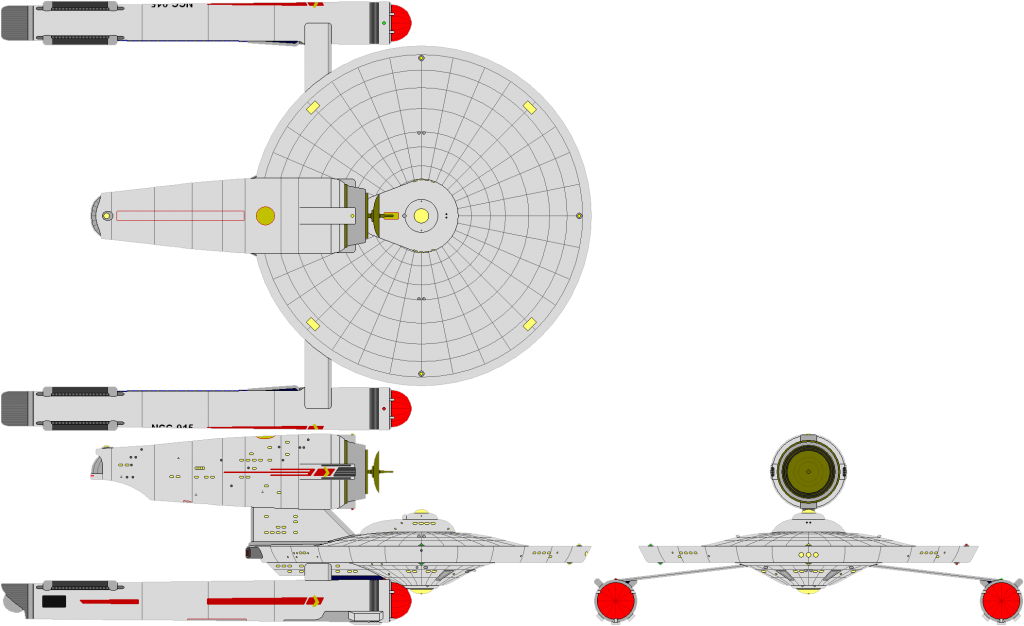«Last Updated on January 3, 2024 »
design by John Bandow
NOTES:
The Star Ranger class was designed to arrive quickly in an area of space and bring it’s full research and exploration capabilities to bear. To help achieve this goal, the decision was made to move the main engineering systems into the primary hull and re-engineer the secondary hull to support labs, science station and crew quarters. Unlike its cousin, the Maine class, the Star Ranger class placed the astrophysics labs in the primary hull to take advantage of the direct plasma energy from the warp power system.
The Star Ranger class also used a wider “stance” with it’s warp nacelles. This design gave the Star Ranger class greater acceleration, although fuel consumption was slightly higher. The wider stance of the nacelles also allowed for more accurate sensor readings while at warp, making the Star Ranger class a prime candidate for FTL research missions.
The Mk I was also an effective light cruiser in combat, with two engaging Klingon forces during the Organian conflict. The Star Ranger her self was also instrumental in curtailing pirate operation near Orion space. The Mk I’s maneuverability and medium firepower meant it could easily engage raiders and other medium class vessels with success.
In early 2268, the Mk III was launched. The Mk III, which would go on to server into the late 2270s, was well armed, with combat capability surpassing other vessels in it’s class range. The Mk III’s massive and powerful FP-4 torpedo system made the ship tremendously dangerous at medium range and planners immediate began investigating the use of the Star Ranger class as a major combat platform. However, the FP-4 was not as easily integrated into the Mk III as previous thought. By 2270, two separate incidents had the main torpedo system releasing radiation into the lower hull of the ship after firing the FP-4. The resulting investigation would go on to produce the improved firing tubes of the FP-4 found on the Enterprise class and later vessels, but the Star Ranger class required a suppressant system be installed to counteract the torpedoes radiation. The system was installed on the five new ships to be built, but could not easily be installed on the previous seven hulls still in service. The decision was made to retrofit these seven into the new Star Range II class.
Of the 12 Star Rangers class vessels fielded, 7 Mk Is are being converted to other classes, while 5 Mk III remain in active service. The Star Ranger class was constructed at New Aberdeen and Proxima Centaur shipyards.
| Construction Data: | ||
| Model – | Mk I | Mk III |
| Ship Class – | XI | XI |
| Date Entering Service – | 2260 | 2268 |
| Number Constructed – | 7 | 5 |
| Hull Data: | ||
| Superstructure Points – | 28 | 28 |
| Damage Chart – | C | C |
| Size: | ||
| Length – | m | m |
| Width – | m | m |
| Height – | m | m |
| Weight – | 171,185 mt | 171,803 mt |
| Cargo: | ||
| Total SCU – | 193.2 SCU | 193.2 SCU |
| Cargo Capacity – | 9,660 mt | 9,660 mt |
| Landing Capacity – | None | None |
| Equipment Date: | ||
| Control Computer Type – | M-4 | M-4 |
| Transporters: | ||
| Standard 6-person – | 3 | 3 |
| Emergency 22-person – | 3 | 3 |
| Cargo – | 2 | 2 |
| Other Data: | ||
| Crew – | 368 | 368 |
| Passengers – | 20 | 20 |
| Shuttlecraft – | 8 | 8 |
| Engines And Power Data: | ||
| Total Power Units Available – | 38 | 44 |
| Movement Point Ratio – | 3/1 | 3/1 |
| Warp Engine Type – | FWC-1 | FWC-1 |
| Number – | 2 | 2 |
| Power Units Available – | 16 ea. | 16 ea. |
| Stress Chart – | O/M | O/M |
| Max Safe Cruising Speed – | Warp 7 | Warp 7 |
| Emergency Speed – | Warp 9 | Warp 9 |
| Impulse Engine Type – | FIC-3 | FIF-1 |
| Power Units Available – | 6 | 12 |
| Weapons And Firing Data: | ||
| Beam Weapon Type – | FH-7 | FH-10 |
| Number – | 6 | 6 |
| Firing Arcs – | 2 f/p, 2 f, 2 f/s | 2 f/p, 2 f, 2 f/s |
| Firing Chart – | Q | W |
| Maximum Power – | 4 | 7 |
| Damage Modifiers: | ||
| +3 | (-) | (1-10) |
| +2 | (1-8) | (11-17) |
| +1 | (9-14) | (18-20) |
| Torpedo Weapon Type – | FP-1 | FP-4 |
| Number – | 2 | 2 |
| Firing Arcs – | 2 f | 2 f |
| Firing Chart – | L | S |
| Power to Arm – | 1 | 1 |
| Damage – | 10 | 20 |
| Shield Data: | ||
| Deflector Shield Type – | FSK | FSO |
| Shield Point Ratio – | 1/2 | 1/3 |
| Maximum Shield Power – | 14 | 16 |
| Combat Efficiency: | ||
| D – | 96 | 124 |
| WDF – | 28 | 68.8 |

